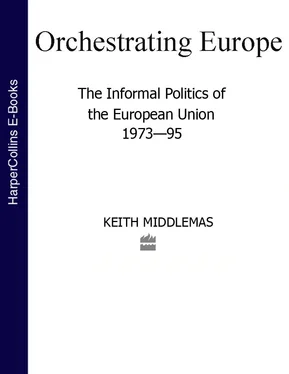Unfortunately, as Tsoukalis has pointed out, the Treaty of Rome provided ‘very little, if any, guidance with respect to monetary policy’. This was hardly surprising since conventional wisdom at the time assumed that the multilateral arrangements enshrined in the Bretton Woods agreements could be fulfilled – and did not envisage their imminent demise. Expectations were high, but the Treaty’s provisions for monetary integration or cooperation (arts 104ff.) were rather pale and dim, stipulating the liberalization of payments on both current and capital accounts. Within a framework of overall equilibrium in the balance of payments, member states were enjoined to pursue policies directed at high employment and stable prices. To accomplish this, it was seen as necessary – and apparently sufficient – that there should be a loose coordination of economic policy accompanied by the creation of an advisory monetary committee to observe, report and comment on current problems. Although exchange rate policy fell within the purview of this body, it remained a national prerogative. Should countries face difficulties, the Community could offer financial assistance in addition to making recommendations, but no fund for this was created.
The first decade of the EEC’s existence brought various proposals but few achievements. It was characterized by almost uninterrupted balance of payments surpluses for the EEC-members and a parallel decline in the position of both reserve currencies, the dollar and sterling. After the devaluations of the French franc in 1958, the payments situation within the Community attained some equilibrium. The small, five-per-cent revaluations by the deutschmark and the guilder in 1961 stemmed largely from the size of their respective surpluses with non-members. The only internal EEC crisis was the Italian deficit in 1963–4 which was resolved by non-Community credits and without recourse to changes in exchange rates. Several initiatives for institutional change and closer monetary integration came from the European Parliament and the Commission. 25Suggestions for closer consultations and the creation of a separate committee of central bankers were accepted in 1961 and 1964 respectively. However, more radical proposals, if not rejected outright, found little positive support among the member states, partly because monetary reform was seen as an issue that required the involvement of the USA and the UK, and partly because the ever-open question of British membership of the Community made several members reluctant to press ahead with more drastic schemes.
Nonetheless, the increasing outflow of dollars and the need for a common line by the ‘surplus’ countries (which included all the EEC states) kept the issue of regional monetary reform on the agenda. In 1964 the French finance minister Giscard d’Estaing proposed the creation of a new reserve unit to eliminate use of the dollar and to serve the needs of intra-European trade. This idea was killed by a combination of the point-blank refusal of the US to contemplate such arrangements, the reluctance of some EEC partners, and a policy conflict within the French government. Jacques Rueff, architect of the French reform programme of 1958, favoured instead an attack on the pre-eminence of the dollar, through using the ‘rules’ of the international system rather than through changing them. Since the dollar was convertible into gold, France decided in 1965 simply to do just that; a decision that provoked d’Estaing’s resignation. Although member states shared France’s underlying concern, they were uneasy about these tactics; and varied in their degree of susceptibility to American diplomatic pressure. On this last point, West Germany was particularly sensitive to US pressures, since the country depended upon the large American troop presence for its security.
A further impetus towards creating a Community attitude on monetary problems came from the decision in 1964 to adopt a common ‘unit of account’ for determining national prices. This implied that domestic prices would need to adjust proportionately to any future change in exchange rates. Although such adjustments were considered unlikely, the Commission wanted mechanisms to reduce the chances further still. At this point it faced opposition on the grounds that tying down one part of the monetary equation made no sense without tightening other components – a line of argument which had already been voiced by German delegations at various international gatherings for over a decade. They demanded economic policy coordination as a prerequisite for monetary union.
The essential underlying assumption that international parities were somehow immutable was punctured by the crises of 1967–8. When sterling devalued in November 1967, a two-tier gold market was introduced in March 1968. As speculation built up against the franc, France introduced exchange controls in spring 1968. Germany provided a safe haven for funds but the government denied that an overvalued DM had caused the problem. Instead, in autumn 1968, it imposed extra taxes on exports and took fiscal measures to encourage imports. The Bundesbank’s stubborn refusal to revalue, despite massive pressure, worried all concerned and pressure for a realignment of exchange rates could not be avoided. But it was a symptom of the depth of the conflict that when the decision was made, the action was not coordinated. France, unilaterally, devalued by 11.1% in September 1969. With German honour thus satisfied, the DM was allowed to float that same month and was formally revalued by 9.3% the following month.
These events produced a surge of interest in regional solutions. The Commission tabled two memoranda in the course of 1968, and in February 1969 the so-called ‘Barre Report’ was submitted. Although the reports differed in emphasis and tactics, they agreed on creating a new reserve unit, improving policy coordination and a establishing a mutual aid system. The Council of Ministers responded, since it also ‘recognized the need for fuller alignment of economic policies in the community and for an examination of the scope for intensifying monetary cooperation’. Even so, there was no immediate follow-up. Meanwhile, the need for some initiative was underlined by the situation created by the 1969 currency realignment. Since neither France nor Germany had wanted national farm prices to change in line with the new exchange rates, (rather than allow the CAP to collapse) the Commission had to produce a system of ‘green’ exchange rates to preserve the fiction of common price levels.
It was some relief when, prompted by the German chancellor, Willi Brandt, the Hague summit of December 1969 endorsed the aim of ‘Economic and Monetary Union’ (EMU) and set up the Werner Group. Although Brandt’s proposal seemed a major departure from the usual German line of insisting on the primacy of prior policy coordination, the Werner Group very soon found itself embroiled in old conflicts. Two schools of thought prevailed: the ‘monetarist’, which saw fixed exchange rates as a means of forcing policy coordination, and the ‘economist’ school, represented by Germany and the Netherlands, which saw the maintenance of fixed parities as impossible without convergent economic policies. The Werner Report, submitted in October 1970, adopted a compromise position. It called for the realization within ten years of complete and irreversible convertibility, closely aligned exchange rates, the full liberalization of capital movements and the creation of a common central banking system.
To achieve these ends it recommended a narrowing of the margins of fluctuation (from 1.5% either side of par) and a better organization of policy cooperation, especially in the area of foreign monetary policy. It took until March 1971 before the measures were approved. Although the French endorsed the monetarist approach, they wanted to avoid at all costs any discussion on the political and institutional aspects of EMU. But it was exactly a commitment on these aspects that Germany and the Netherlands saw as the price for their concessions. As a result, the resolution approving the goal of EMU left the questions of the transfer of power and institutional reform undecided.
Читать дальше









![Brian Thompson - A Monkey Among Crocodiles - The Life, Loves and Lawsuits of Mrs Georgina Weldon – a disastrous Victorian [Text only]](/books/704922/brian-thompson-a-monkey-among-crocodiles-the-life-thumb.webp)


